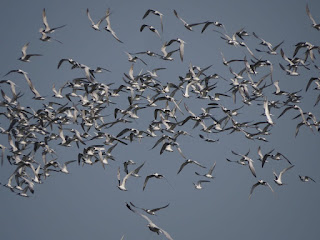I spent the entire year in Canada and managed to see 349 species of bird.
This post is heavy on the photos:
The year started off strong when Ed, Alison and I found this Sabine's Gull at St. Vincent's in late January. One of very few for North America in the winter months:
Much of the winter birding in Newfoundland relies on gulls for our entertainment. This gull stood out from the crowd:
Probable Thayer's Gull
Another highlight from the winter was this Fieldfare in Lumsden - a Eurasian species, with about 9 records in the province:
One of my goals this year was to spend more time exploring areas that have less coverage. I managed to get to Terra Nova National Park in central Newfoundland for a weekend.
Spruce Grouse is fairly common across the island - especially Terra Nova - but nonexistent on the Avalon peninsula:
A welcome introduced species to our woodlands!
One May 29-30, Catherine and I did our annual big day in support of Bird Studies Canada. We raised over $1500 and saw a record 96 species in a 24 hour period on the Avalon peninsula. Willow Ptarmigan was one of our highlights:
The day after the big day I came across this Cave Swallow - only the second record for the province, and likely an individual from the Bahama race, adding to its significance:
While trying to relocate the swallow, Blair Fleming and I found this Euro Golden-Plover:
As I've now gotten more used to, the breeding season rushed by and young birds were starting their lives with gusto. This Horned Lark was in an unfamiliar plumage:
One of my favourite photos from 2016 - an Arctic Blue sunning itself on the coastal barrens at Cape Spear:
In late July two rare terns graced us at Renews: a Royal Tern and Sandwich Tern
Then it was back across the island before heading to Nova Scotia, Ontario, and BC for 3 months.
A Merlin chasing a Great Blue Heron from its territory in the Codroy Valley:
An unprecedented influx of Cory's Shearwater to Newfoundland waters occurred in early August. It will be interesting to see if the phenomena repeats itself in 2017.
In BC I was fortunate to start with a 3-day weekend of all-out birding with John Reynolds. One of the highlights was getting great looks at Lewis's Woodpecker:
The other birding highlight from this month in BC was the annual pelagic off of Ucluelet.
Black-footed Albatross:
In Ontario I took some time off work/school to volunteer at Long Point Bird Observatory.
Migration was in full swing and allowed me to significantly improve two aspects of my birding at Long Point:
identifying birds in flight, and familiarizing myself with chip calls of sparrows.
Large flocks of Common Terns provided great entertainment:
Back in Newfoundland by early November:
I returned just in time to enjoy some excellent finds, including this Hermit Warbler:
December has passed and now it's back to studying the gulls - our birding lifeline in St. John's during the winter.
A recent Kelp Gull was one of the most surprising birds of the year in the province:
2017 promises to be an exciting year: I have a couple of big trips planned, and some longterm projects I hope to start to move forward on - more on these later.
In the spring I will be graduating from medical school and beginning my career. Lots of unknowns still, but these should be sorted out within the next couple months.
Have a great 2017 - may you enjoy many hours enjoying and learning about our nature!




































